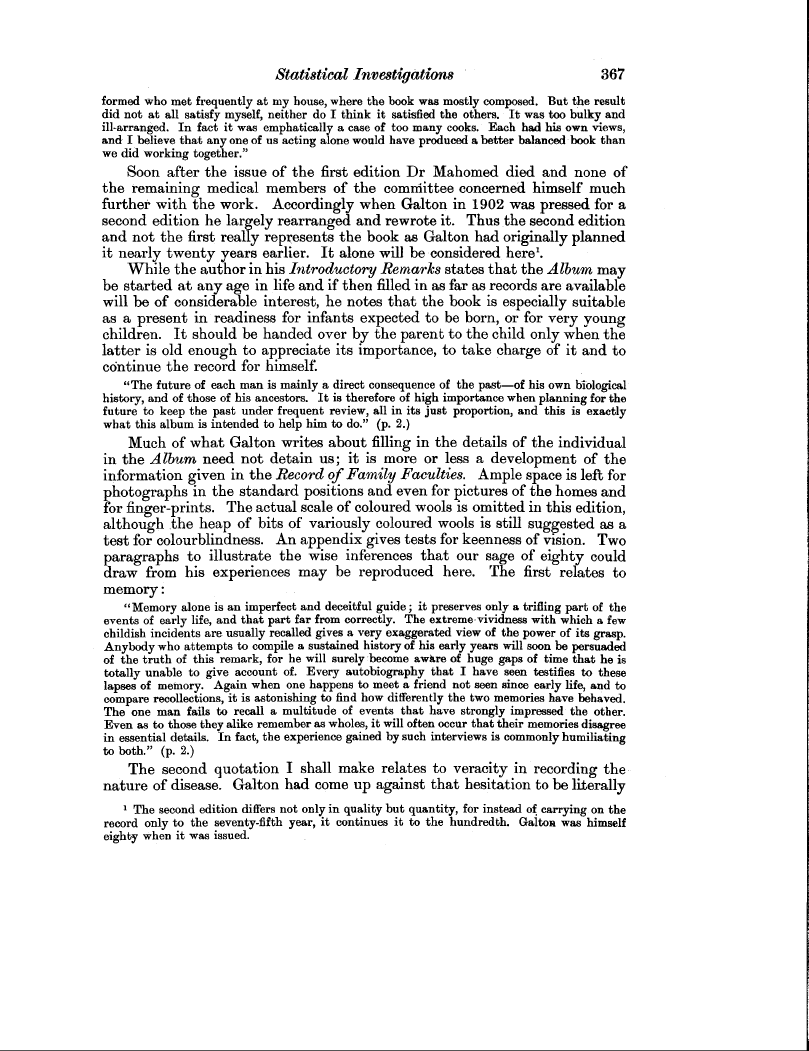Statistical Investigations 367
formed who met frequently at my house, where the book was mostly composed. But the result did not at all satisfy myself, neither do I think it satisfied the others. It was too bulky and ill-arranged. In fact it was emphatically a case of too many cooks. Each had his own views, and I believe that any one of us acting alone would have produced a better balanced book than
we did working together."
Soon after the issue of the first edition Dr Mahomed died and none of the remaining medical members of the comniittee concerned himself much further with the work. Accordingly when Galton in 1902 was pressed for a second edition he largely rearranged and rewrote it. Thus the second edition and not the first really represents the book as Galton had originally planned it nearly twenty years earlier. It alone will be considered here'.
While the author in his Introductory Remarks states that the Album may be started at any age in life and if then filled in as far as records are available will be of considerable interest, he notes that the book is especially suitable as a present in readiness for infants expected to be born, or for very young children. It should be handed over by the parent to the child only when the latter is old enough to appreciate its importance, to take charge of it and to continue the record for himself.
"The future of each man is mainly a direct consequence of the past-of his own biological history, and of those of his ancestors. It is therefore of high importance when planning for the future to keep the past under frequent review, all in its just proportion, and this is exactly
what this album is intended to help him to do." (p. 2.)
Much of what Galton writes about filling in the details of the individual in the Album need not detain us; it is more or less a development of the information given in the Record of Family Faculties. Ample space is left for photographs in the standard positions and even for pictures of the homes and for finger-prints. The actual scale of coloured wools is omitted in this edition, although the heap of bits of variously coloured wools is still suggested as a test for colourblindness. An appendix gives tests for keenness of vision. Two paragraphs to illustrate the wise inferences that our sage of eighty could draw from his experiences may be reproduced here. The first relates to memory
"Memory alone is an imperfect and deceitful guide; it preserves only a trifling part of the events of early life, and that part far from correctly. The extreme- vividness with which a few childish incidents are usually recalled gives a very exaggerated view of the power of its grasp. Anybody who attempts to compile a sustained history of his early years will soon be persuaded of the truth of this remark, for be will surely become aware of huge gaps of time that he is totally unable to give account of. Every autobiography that I have seen testifies to these lapses of memory. Again when one happens to meet a friend not seen since early life, and to compare recollections, it is astonishing to find how differently the two memories have behaved. The one man fails to recall a multitude of events that have strongly impressed the other. Even as to those they alike remember as wholes, it will often occur that their memories disagree
in essential details. In fact, the experience gained by such interviews is commonly humiliating to both." (p. 2.)
The second quotation I shall make relates to veracity in recording the nature of disease. Galton had come up against that hesitation to be literally
' The second edition differs not only in quality but quantity, for instead of carryingg on the record only to the seventy-fifth year, it continues it to the hundredth. Galtoa was himself eighty when it was issued.

